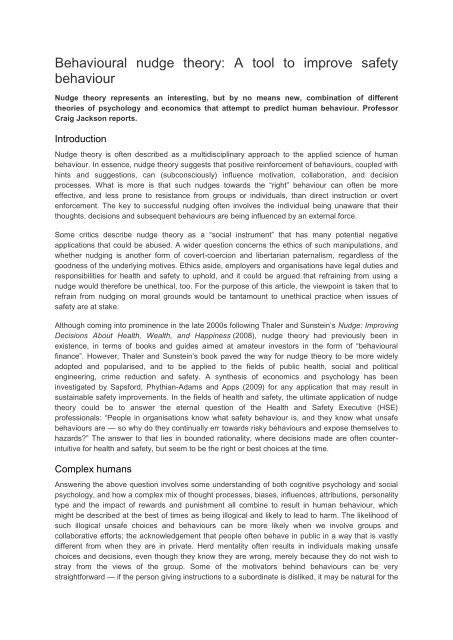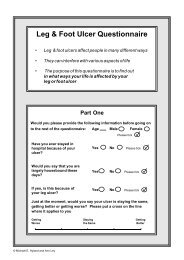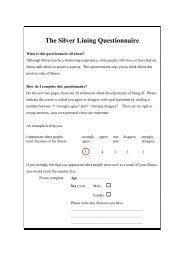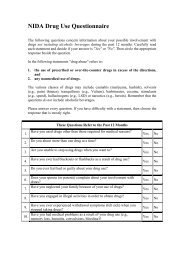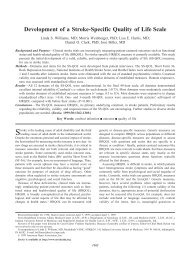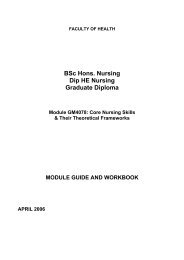Behavioural nudge theory: A tool to improve safety behaviour
Behavioural nudge theory: A tool to improve safety behaviour
Behavioural nudge theory: A tool to improve safety behaviour
Create successful ePaper yourself
Turn your PDF publications into a flip-book with our unique Google optimized e-Paper software.
<strong>Behavioural</strong> <strong>nudge</strong> <strong>theory</strong>: A <strong><strong>to</strong>ol</strong> <strong>to</strong> <strong>improve</strong> <strong>safety</strong><br />
<strong>behaviour</strong><br />
Nudge <strong>theory</strong> represents an interesting, but by no means new, combination of different<br />
theories of psychology and economics that attempt <strong>to</strong> predict human <strong>behaviour</strong>. Professor<br />
Craig Jackson reports.<br />
Introduction<br />
Nudge <strong>theory</strong> is often described as a multidisciplinary approach <strong>to</strong> the applied science of human<br />
<strong>behaviour</strong>. In essence, <strong>nudge</strong> <strong>theory</strong> suggests that positive reinforcement of <strong>behaviour</strong>s, coupled with<br />
hints and suggestions, can (subconsciously) influence motivation, collaboration, and decision<br />
processes. What is more is that such <strong>nudge</strong>s <strong>to</strong>wards the “right” <strong>behaviour</strong> can often be more<br />
effective, and less prone <strong>to</strong> resistance from groups or individuals, than direct instruction or overt<br />
enforcement. The key <strong>to</strong> successful nudging often involves the individual being unaware that their<br />
thoughts, decisions and subsequent <strong>behaviour</strong>s are being influenced by an external force.<br />
Some critics describe <strong>nudge</strong> <strong>theory</strong> as a “social instrument” that has many potential negative<br />
applications that could be abused. A wider question concerns the ethics of such manipulations, and<br />
whether nudging is another form of covert-coercion and libertarian paternalism, regardless of the<br />
goodness of the underlying motives. Ethics aside, employers and organisations have legal duties and<br />
responsibilities for health and <strong>safety</strong> <strong>to</strong> uphold, and it could be argued that refraining from using a<br />
<strong>nudge</strong> would therefore be unethical, <strong>to</strong>o. For the purpose of this article, the viewpoint is taken that <strong>to</strong><br />
refrain from nudging on moral grounds would be tantamount <strong>to</strong> unethical practice when issues of<br />
<strong>safety</strong> are at stake.<br />
Although coming in<strong>to</strong> prominence in the late 2000s following Thaler and Sunstein’s Nudge: Improving<br />
Decisions About Health, Wealth, and Happiness (2008), <strong>nudge</strong> <strong>theory</strong> had previously been in<br />
existence, in terms of books and guides aimed at amateur inves<strong>to</strong>rs in the form of “<strong>behaviour</strong>al<br />
finance”. However, Thaler and Sunstein’s book paved the way for <strong>nudge</strong> <strong>theory</strong> <strong>to</strong> be more widely<br />
adopted and popularised, and <strong>to</strong> be applied <strong>to</strong> the fields of public health, social and political<br />
engineering, crime reduction and <strong>safety</strong>. A synthesis of economics and psychology has been<br />
investigated by Sapsford, Phythian-Adams and Apps (2009) for any application that may result in<br />
sustainable <strong>safety</strong> <strong>improve</strong>ments. In the fields of health and <strong>safety</strong>, the ultimate application of <strong>nudge</strong><br />
<strong>theory</strong> could be <strong>to</strong> answer the eternal question of the Health and Safety Executive (HSE)<br />
professionals: “People in organisations know what <strong>safety</strong> <strong>behaviour</strong> is, and they know what unsafe<br />
<strong>behaviour</strong>s are — so why do they continually err <strong>to</strong>wards risky <strong>behaviour</strong>s and expose themselves <strong>to</strong><br />
hazards?” The answer <strong>to</strong> that lies in bounded rationality, where decisions made are often counterintuitive<br />
for health and <strong>safety</strong>, but seem <strong>to</strong> be the right or best choices at the time.<br />
Complex humans<br />
Answering the above question involves some understanding of both cognitive psychology and social<br />
psychology, and how a complex mix of thought processes, biases, influences, attributions, personality<br />
type and the impact of rewards and punishment all combine <strong>to</strong> result in human <strong>behaviour</strong>, which<br />
might be described at the best of times as being illogical and likely <strong>to</strong> lead <strong>to</strong> harm. The likelihood of<br />
such illogical unsafe choices and <strong>behaviour</strong>s can be more likely when we involve groups and<br />
collaborative efforts; the acknowledgement that people often behave in public in a way that is vastly<br />
different from when they are in private. Herd mentality often results in individuals making unsafe<br />
choices and decisions, even though they know they are wrong, merely because they do not wish <strong>to</strong><br />
stray from the views of the group. Some of the motiva<strong>to</strong>rs behind <strong>behaviour</strong>s can be very<br />
straightforward — if the person giving instructions <strong>to</strong> a subordinate is disliked, it may be natural for the
subordinate <strong>to</strong> want <strong>to</strong> resist complying with such instructions — either on an au<strong>to</strong>matic/instinctive<br />
level, or on a more considered and rationalised decision-making plane.<br />
In short, a successful <strong>nudge</strong> could be any aspect of the environment that influences a desired<br />
<strong>behaviour</strong>, and makes that action more likely <strong>to</strong> occur. Common examples of <strong>nudge</strong>s include the use<br />
of black and yellow markings <strong>to</strong> indicate hazards (and thereby influence cautious movements from<br />
individuals); ropes used in banks <strong>to</strong> direct the flow of cus<strong>to</strong>mers; and three-coloured traffic-light<br />
systems that are used <strong>to</strong> indicate priority or importance of information. In fact, colour-coding is<br />
possibly one of the oldest workplace <strong>nudge</strong>s; “green” is for recycling or healthy options; “red” is for<br />
danger; and “yellow” is for caution. Shapes, <strong>to</strong>o, provide a continuous <strong>nudge</strong>, with an obvious<br />
example being the Highway Code — triangular traffic signs are warnings, while circular signs are<br />
rules, and these “shape-colour rules” become adopted by us throughout life.<br />
Subconscious “choices”<br />
As well as being ubiqui<strong>to</strong>us and keeping a consistent presence in the context of the “rules” of shapes<br />
and colours we learn throughout life, <strong>nudge</strong>s can be cost-effective and work best when the recipient<br />
of the <strong>nudge</strong> believes the decision they have “made” has been of their own volition. Further, <strong>nudge</strong>s<br />
can be even more effective if the recipient of the <strong>nudge</strong> makes a decision, perhaps without even<br />
being aware they have made a decision, ie “It is just obvious that refuse for recycling belongs in the<br />
green bin.”<br />
A <strong>nudge</strong> below the radar of conscious realisation is the best <strong>nudge</strong> of all, and this is where “choice<br />
architecture” emerges; choice architecture is the possible array of potential decisions or <strong>behaviour</strong>s<br />
that individuals or groups can engage in. The assortment of confectionary products in a shop is not a<br />
coincidence, and is often a hotly contested point of sale with different confectioners wanting their<br />
products in that sweet-spot that seems <strong>to</strong> catch the potential buyer’s eye. Shelving, mirrors, lighting<br />
and smells are all used <strong>to</strong> <strong>nudge</strong> the cus<strong>to</strong>mer <strong>to</strong>wards the target product. Intuitively then, as<br />
something that is proven <strong>to</strong> work in retail “science”, the <strong>nudge</strong> is surely something that has massive<br />
potential in the field of workplace <strong>safety</strong>.<br />
How can people be influenced or compelled <strong>to</strong> make the right decisions? Ergonomists and systems<br />
designers have a long-standing relationship with <strong>nudge</strong>s, and have relied on the users’ mental<br />
shortcuts (known as “availability heuristics” and “representative heuristics”, which are both unreliable<br />
and an error-ridden basis of poor decisions) and mental models <strong>to</strong> shape the design and (<strong>safety</strong>)<br />
function of interfaces and equipment.<br />
The fly image that is baked in the ceramic of urinals at Amsterdam Schiphol airport is the most<br />
commonly given example of a sub-conscious <strong>nudge</strong> providing a cost-effect solution. Although<br />
sounding like an apocryphal s<strong>to</strong>ry, Jos van Bedoff noticed during his military service in the 1960s that<br />
an army urinal with a small dot on it was much cleaner than the other urinals. This idea was<br />
implemented in urinals at Schiphol airport in the 1980s and, after installation, spillage and subsequent<br />
cleaning costs were reduced by 80% following the subconscious targeting of the fly by urinal users.<br />
Unintentional mistakes and deliberate violations<br />
Nudges can be used in a variety of ways <strong>to</strong> tackle a variety of failings, including both the deliberate<br />
and conscious-<strong>safety</strong> violations (associated with reflective decision-making), as well as the subconscious<br />
family of unintentional errors (au<strong>to</strong>matic decision-making). Sub-conscious “under the radar”<br />
<strong>nudge</strong>s have the potential <strong>to</strong> address both of these types of failings, but perhaps the deliberate type of<br />
violation may be the hardest <strong>to</strong> address. Nudges can be used in workplaces <strong>to</strong>:<br />
prompt safe practice and actions
encourage the safe way <strong>to</strong> become the “only way”<br />
make the safest choice the default choice<br />
encourage workers <strong>to</strong> assess if they have the correct resources<br />
reduce complacency of <strong>safety</strong> attitudes<br />
back up specific on-going campaigns (eg hand-washing; driver <strong>safety</strong>)<br />
encourage worker participation in <strong>safety</strong> programmes<br />
increase awareness of surroundings and (hazardous) situations<br />
gain managerial commitment <strong>to</strong> <strong>safety</strong> initiatives.<br />
Nudges also benefit from being so subtle that they are not subject <strong>to</strong> the negative reception that overt<br />
health and <strong>safety</strong> messages often receive from individuals, due <strong>to</strong> the negative perceptions of the “‘elf<br />
‘n’ <strong>safety</strong>” culture.<br />
Limited applications<br />
Because deliberate <strong>safety</strong> violations can occur for a wide variety of reasons and for different types of<br />
gain and benefit, there may not be a simple one-<strong>nudge</strong>-fix-all approach that can be used, especially<br />
concerning attitudes, prejudices, bigotry and curious motives that can underlie such actions. Such<br />
pro-<strong>safety</strong> violation attitudes can be deeply ingrained within individuals, while some <strong>nudge</strong>s are only<br />
fleeting in their effect, so their ability <strong>to</strong> tackle deeply held “recidivist” unsafe <strong>behaviour</strong>s could be<br />
challenged.<br />
In addition, there may be some occasions when workforces or individuals, once they realise they have<br />
been the “victims” of <strong>nudge</strong>s and manipulation, may engage in the deliberate ignoring of such <strong>nudge</strong>s<br />
as a form of defiance. These unwanted outcomes can be referred <strong>to</strong> as the “revenge effects” of any<br />
<strong>nudge</strong> that goes wrong.<br />
Another potential negative aspect of <strong>safety</strong> <strong>nudge</strong>s could be where the <strong>nudge</strong> stimulus may distract<br />
the worker from what they were doing, <strong>to</strong> the extent that an accident may occur. Although sounding<br />
fanciful, such possible negative outcomes need <strong>to</strong> be assessed alongside the potential benefits such<br />
<strong>nudge</strong>s may provide in relation <strong>to</strong> any specific hazard. The desensitisation and habituation of<br />
workforces <strong>to</strong> <strong>nudge</strong>s might also mean that <strong>nudge</strong>s need an occasional refresher in order <strong>to</strong> have the<br />
worker continue <strong>to</strong> attenuate <strong>to</strong> them (even subconsciously).<br />
Summary<br />
Nudging has the potential <strong>to</strong> change <strong>behaviour</strong> and <strong>improve</strong> <strong>safety</strong> where regulation and enforcement<br />
often fail. The House of Lords Science and Technology Committee presented findings in 2011<br />
following an evidence-gathering exercise about the potential of <strong>behaviour</strong>al change. They<br />
acknowledged a clear additional role for non-regula<strong>to</strong>ry input in the area (such as <strong>nudge</strong>s and<br />
selective choice architecture) and, although expressing caution about a lack of reliable scientific<br />
evidence at the time, an open mind seems <strong>to</strong> have been reserved by the committee. Nudging and the<br />
architecture of choice are simply additional <strong><strong>to</strong>ol</strong>s for <strong>safety</strong> managers <strong>to</strong> use in order <strong>to</strong> change<br />
<strong>behaviour</strong>al actions, but the real success of them will materialise when the <strong>nudge</strong> is seen as second<br />
nature. In some areas of proactive <strong>safety</strong> practice in certain sec<strong>to</strong>rs, thankfully that moment has<br />
already arrived. What is needed now are good studies and reliable intervention research that will<br />
allow the tangible benefits of <strong>nudge</strong>s <strong>to</strong> be evaluated objectively.
References<br />
House of Lords Science and Technology Committee (2011): Second Report — Behaviour<br />
Change<br />
<strong>Behavioural</strong> Economics: A Review of the Literature and Proposals for Further Research in the<br />
Context of Workplace Health and Safety, Sapsford D, Phythian-Adams S L, Apps E, HSE Books,<br />
2009<br />
Nudge: Improving Decisions about Health, Wealth, and Happiness, Thaler R, Sunstein C, Yale<br />
University Press, 2008


